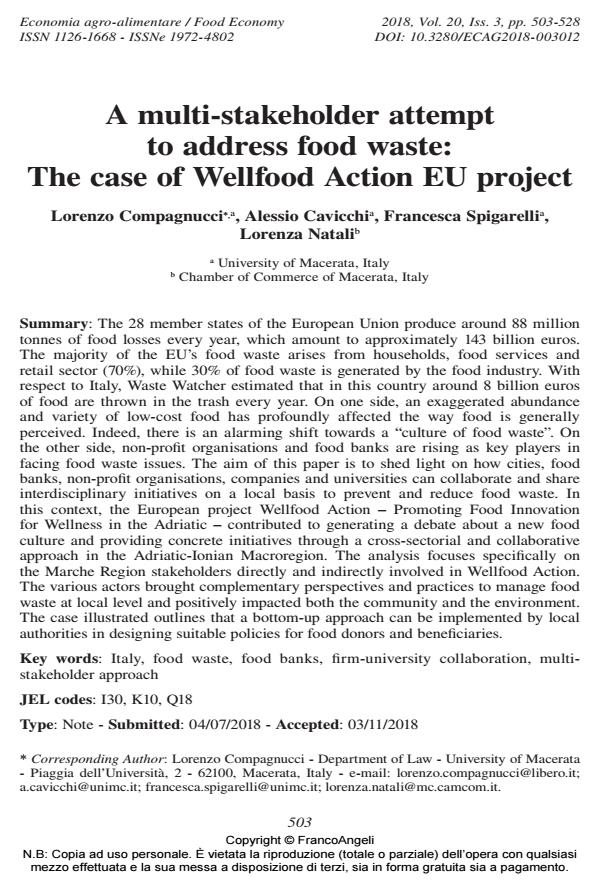A multi-stakeholder attempt to address food waste: The case of Wellfood Action EU project
Journal title ECONOMIA AGRO-ALIMENTARE
Author/s Lorenzo Compagnucci, Alessio Cavicchi, Francesca Spigarelli, Lorenza Natali
Publishing Year 2019 Issue 2018/3
Language English Pages 26 P. 503-528 File size 175 KB
DOI 10.3280/ECAG2018-003012
DOI is like a bar code for intellectual property: to have more infomation
click here
Below, you can see the article first page
If you want to buy this article in PDF format, you can do it, following the instructions to buy download credits

FrancoAngeli is member of Publishers International Linking Association, Inc (PILA), a not-for-profit association which run the CrossRef service enabling links to and from online scholarly content.
The 28 member states of the European Union produce around 88 million tonnes of food losses every year, which amount to approximately 143 billion euros. The majority of the EU’s food waste arises from households, food services and retail sector (70%), while 30% of food waste is generated by the food industry. With respect to Italy, Waste Watcher estimated that in this country around 8 billion euros of food are thrown in the trash every year. On one side, an exaggerated abundance and variety of low-cost food has profoundly affected the way food is generally perceived. Indeed, there is an alarming shift towards a "culture of food waste". On the other side, non-profit organisations and food banks are rising as key players in facing food waste issues. The aim of this paper is to shed light on how cities, food banks, non-profit organisations, companies and universities can collaborate and share interdisciplinary initiatives on a local basis to prevent and reduce food waste. In this context, the European project Wellfood Action - Promoting Food Innovation for Wellness in the Adriatic - contributed to generating a debate about a new food culture and providing concrete initiatives through a cross-sectorial and collaborative approach in the Adriatic-Ionian Macroregion. The analysis focuses specifically on the Marche Region stakeholders directly and indirectly involved in Wellfood Action. The various actors brought complementary perspectives and practices to manage food waste at local level and positively impacted both the community and the environment. The case illustrated outlines that a bottom-up approach can be implemented by local authorities in designing suitable policies for food donors and beneficiaries.
Keywords: Italy, food waste, food banks, firm-university collaboration, multistakeholder approach
Jel codes: I30, K10, Q18
- Food Loss and Waste, a global responsibility?! Nino Adamashvili, Filomena Chiara, Mariantonietta Fiore, in ECONOMIA AGRO-ALIMENTARE 3/2020 pp.825
DOI: 10.3280/ECAG2019-003014
Lorenzo Compagnucci, Alessio Cavicchi, Francesca Spigarelli, Lorenza Natali, A multi-stakeholder attempt to address food waste: The case of Wellfood Action EU project in "ECONOMIA AGRO-ALIMENTARE" 3/2018, pp 503-528, DOI: 10.3280/ECAG2018-003012